

Episodic Memory Retrieval Functionally Relies on Very Rapid Reactivation of Sensory Information. The blink of an eye is one of the fastest reactions the human body can make - but is a slow process compared to the recovery of memory.

Using a brain scanner, scientists have discovered that memories can be recovered in just a tenth of a second - around a third of the time needed to blink. Previous research had estimated this at around five tenths of a second. The researchers also found retrieval can be obstructed if the person is subjected to repetitive Transcranial Magnetic Stimulation (rTMS), in which a magnetic coil is placed on their head. Images from Johns Hopkins University reveal synapses forming on nerve cells. Scientists from Johns Hopkins University in Baltimore created mice with brain receptors that glowed under the light of a special microscopeReceptors help nerve cells strengthen their connections to form memories They were able to see nerve cells clearly, to observe how memories formThis has been previously impossible, until the new imaging technique Images show that tickling the whiskers of mice increased the number of AMPA receptors on their nerve cells - forming memories By Sarah Griffiths for MailOnline Published: 19:22 GMT, 5 February 2015 | Updated: 19:56 GMT, 5 February 2015.

Memories really ARE made of this: Researchers uncover how the brain decides what we remember. Found human brain locks down episodic memories in the hippocampusEach recollection committed to a distinct area of individual cells By Mark Prigg Published: 00:16 GMT, 17 June 2014 | Updated: 00:28 GMT, 17 June 2014.
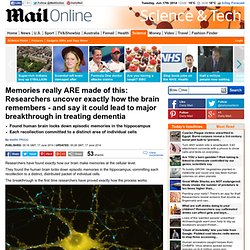
The fabric for weaving memory: To establish long-term memory, neurons have to synthesize new proteins. The details of memory formation are still largely unknown.
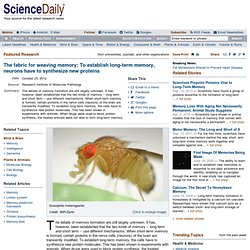
It has, however, been established that the two kinds of memory -- long term and short term -- use different mechanisms. Scientists create new memories by directly changing the brain. Sep. 10, 2013 — By studying how memories are made, UC Irvine neurobiologists created new, specific memories by direct manipulation of the brain, which could prove key to understanding and potentially resolving learning and memory disorders.
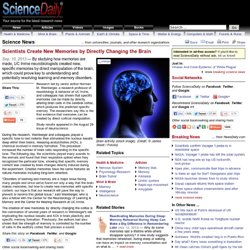
Research led by senior author Norman M. Weinberger, a research professor of neurobiology & behavior at UC Irvine, and colleagues has shown that specific memories can be made by directly altering brain cells in the cerebral cortex, which produces the predicted specific memory. To live and learn: Making memories has to be a speedy business. The brain is plastic -- adapting to the hundreds of experiences in our daily lives by reorganizing pathways and making new connections between nerve cells.

What happened when? How the brain stores memories by time. Before I left the house this morning, I let the cat out and started the dishwasher.
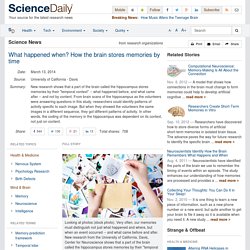
Or was that yesterday? Very often, our memories must distinguish not just what happened and where, but when an event occurred -- and what came before and after. New research from the University of California, Davis, Center for Neuroscience shows that a part of the brain called the hippocampus stores memories by their "temporal context" -- what happened before, and what came after. "We need to remember not just what happened, but when," said graduate student Liang-Tien (Frank) Hsieh, first author on the paper published March 5 in the journal Neuron. First Image Of Memories Being Made.
The ability to learn and to establish new memories is essential to our daily existence and identity; enabling us to navigate through the world.
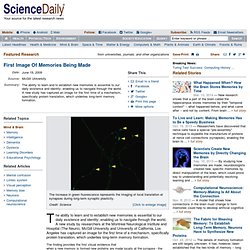
A new study by researchers at the Montreal Neurological Institute and Hospital (The Neuro), McGill University and University of California, Los Angeles has captured an image for the first time of a mechanism, specifically protein translation, which underlies long-term memory formation. Scientists map process by which brain cells form long-term memories. Scientists at the Gladstone Institutes have deciphered how a protein called Arc regulates the activity of neurons -- providing much-needed clues into the brain's ability to form long-lasting memories.

These findings, reported today in Nature Neuroscience, also offer newfound understanding as to what goes on at the molecular level when this process becomes disrupted. Led by Gladstone Senior Investigator Steve Finkbeiner, MD, PhD, this research delved deep into the inner workings of synapses. Synapses are the highly specialized junctions that process and transmit information between neurons. Most of the synapses our brain will ever have are formed during early brain development, but throughout our lifetimes these synapses can be made, broken and strengthened. Synapses that are more active become stronger, a process that is essential for forming new memories. But Dr. Novel storage mechanism allows command, control of memory.
Introductions at a party seemingly go in one ear and out the other.
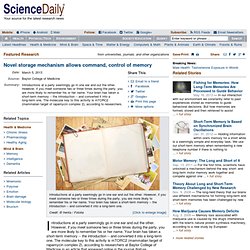
However, if you meet someone two or three times during the party, you are more likely to remember his or her name. Your brain has taken a short-term memory -- the introduction -- and converted it into a long-term one. The molecular key to this activity is mTORC2 (mammalian target of rapamycin complex 2), according to researchers at Baylor College of Medicine in an article that appeared online in the journal Nature Neuroscience. "Memory consolidation is a fundamental process," said Dr. Mauro Costa-Mattioli, assistant professor of neuroscience at BCM and corresponding author of the report.
Actin fibers. Novel memory-enhancing mechanism in brain. UC Irvine researchers have identified a novel mechanism in the brain that boosts memory. In collaboration with scientists at Germany's University of Munster, the UCI team found that a small protein called neuropeptide S can strengthen and prolong memories of everything from negative events to simple objects. According to study leader Rainer Reinscheid, UCI associate professor of pharmaceutical sciences, the discovery could provide important clues about how the brain stores memories and also lead to new treatments for Alzheimer's disease, dementia and other cognitive impairments.
"Additionally, it may help us better understand post-traumatic stress disorder, which involves exaggerated memories of traumatic events," he said. In tests on mice, the researchers observed that if neuropeptide S receptors in the brain were activated immediately after a learning experience, it could be recalled for much longer and with much greater intensity.
Lifelong memories linked to stable nerve connections. Our ability to learn new information and adapt to changes in our daily environment, as well as to retain lifelong memories, appears to lie in the minute junctions where nerve cells communicate, according to a new study by NYU Langone Medicine Center researchers. The study is published online December 3 in the journal Nature. The scientists, led by Wen-Biao Gan, PhD, associate professor of physiology and neuroscience at NYU School of Medicine, discovered that a delicate balancing act occurs in the brain where neuronal connections are continually being formed, eliminated, and maintained. This feat allows the brain to integrate new information without jeopardizing already established memories, the new study suggests. Using a powerful optical imaging technique called two-photon microscopy, Dr. "We've known for a long time that the brain remodels after learning," says Dr.
Dr. Scientists Decipher The Formation Of Lasting Memories. Researchers at Karolinska Institutet have discovered a mechanism that controls the brain's ability to create lasting memories. In experiments on genetically manipulated mice, they were able to switch on and off the animals' ability to form lasting memories by adding a substance to their drinking water. Are search engines and the Internet hurting human memory? The following is excerpted from Clive Thompson’s book Smarter Than You Think: How Technology Is Changing Our Minds for the Better, out now from the Penguin Press. Is the Internet ruining our ability to remember facts?
If you’ve ever lunged for your smartphone during a bar argument (“one-hit father of twerking pop star”—Billy Ray Cyrus!) , then you’ve no doubt felt the nagging fear that your in-brain memory is slowly draining away. As even more fiendishly powerful search tools emerge—from IBM’s Jeopardy! -playing Watson to the “predictive search” of Google Now—these worries are, let’s face it, only going to grow. So what’s going on? The short answer is: No. The longer answer: It’s much, much weirder than that! What’s really happening is that we’ve begun to fit the machines into an age-old technique we evolved thousands of years ago—“transactive memory.” And frankly, our brains have always been terrible at remembering details. The exception is when you’re obsessed with a subject. The Science of Memory.